Like Lassie
Before Kolby met Amelia, she hardly knew what a Collie was. When her trainer suggested a Rough Collie for her next guide dog, Kolby said, “What?”
“You know, like Lassie,” was the response.
“Who?” asked Kolby.
Her trainer laughed, sighed, and said, “Oh, Google it. You make me feel old!”
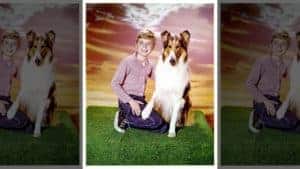
Another Sunny
Kolby had a good bond with her first guide dog, a Golden Retriever called Sunny; but her second guide dog, another Golden named Mo, was just not cut out for the job. He was afraid of everything and could not think independently. After about a year with Kolby, it was decided that Mo would be retired early to a pet home.
(Side note: while some people may know guide dogs for the blind and visually impaired by the term “seeing-eye dogs,” that term is actually copyrighted for the dogs of The Seeing Eye organization.)
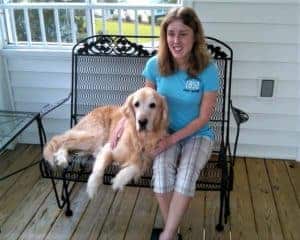
When Kolby’s trainer asked her what kind of dog she was looking for next, she was more prepared to answer than when she had been a newbie handler. “I want another Sunny,” she declared. Kolby, a fast talker and fast walker, needed a guide dog that could keep up with her energetic pace and busy life, a dog that would challenge her and would itself relish challenges and new situations.
Hence her trainer’s Collie suggestion.
The Matching Process
Normally, Kolby would have gone to the Guide Dog Foundation in New York to spend a few weeks there while she was matched with a new dog, but she could not take that much time off while attending college. The GDF takes the matching process very seriously, but they also took her situation into consideration. In addition to interviews with a trainer, Kolby sent in videos for evaluation of her walking style and speed.
When the day came to meet Amelia, Kolby was at the pet store picking up some last minute things for her, but she hurried home after receiving a call saying her new dog had arrived. When she stepped out of the car, actually trembling with excitement, the first thing she noticed was the barking. “Is she supposed to be doing that?” she asked.
“Welcome to life with a Collie!” laughed her trainer.

Kolby discovered that life with a Collie was not like life with a Golden Retriever. Having heard that it takes a certain type of handler to work with a herding breed, she was relieved to find she had that certain something. When her trainer had initially told her that a Collie’s respect and trust had to be earned, Kolby didn’t know what she meant. It clicked when she read an article detailing how the boy who played Timmy spent time at a ranch with the canine actor Lassie to see if he was compatible with the dog.
Kolby said: “I thrive with Amelia. I love how intelligent, enthusiastic, and mentally sound she is. I love our partnership. I will go above and beyond for her, and I know she will do the same for me. We trust each other, and we respect each other.”
Why Isn't She Going?
Kolby related two occasions in particular when Amelia proved she knows how to keep her person safe. Once while crossing a street, Kolby gave Amelia the command “forward” only to have her refuse to move. “Why isn’t she going?” Kolby asked her friend.
“A hybrid just went by,” she explained. With its quiet engine, Kolby hadn’t heard it at all!
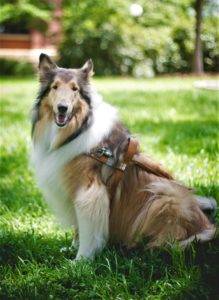
There was another close call at a street crossing when Kolby said “forward” and moved to step off the curb. Amelia quickly jerked her to the left just as a car went speeding by. Both instances were perfect examples of why a guide dog who can think for themselves – as Collies so often do – is crucial. They cannot be robotically obedient; they have to know when not to listen.
I Can Feel Her Thinking
Kolby said Amelia “is always ready to go” and loves working, especially in challenging situations. “Sometimes I can feel her thinking through the harness handle,” Kolby explained. Amelia’s higher drive is perfect for Kolby, right down to the way she pulls into the harness to maintain a taut connection to her.
Personality, lifestyle, environmental factors, and extracurricular activities are all considered when the Guide Dog Foundation matches a handler with a dog. Kolby sings at her church and attends NASCAR races, so it was important to her to have a guide dog that would remain steady and calm in the midst of noise and chaos.
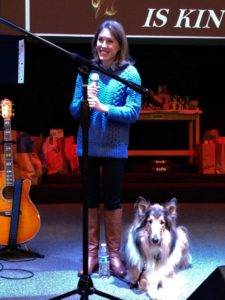
Kolby considers it her responsibility as a handler to make sure that Amelia remains comfortable while accompanying her through these experiences. When they go to NASCAR races, Amelia wears military-grade ear protection called “Mutt Muffs” to preserve her sensitive hearing. Kolby claims that was some of the best $52 she ever spent! Amelia’s unruffled temperament plus her Mutt Muffs allow her to just lie down and sleep through ruckus at the races or loud music at church or concerts.
During the extreme heat of North Carolina summers, Amelia also wears Ruffwear Grip Trex Boots to protect her paw pads from being burned by sun-scorched pavement or asphalt. She is a familiar sight at the local mall, where she goes strutting around in her booties, usually heading straight for the escalators.

Amelia is trained to find escalators on command, along with elevators, chairs, counters, and certain people she knows by name. But she needs no urging when it comes to scouting out escalators. Kolby said, “If she sees an escalator and we don’t go on it, she gets mad at me. She LOVES escalators.” They’re like an amusement ride for her – a justly deserved reward for her very good behavior.
When Kolby goes to the mall with friends or family, she sometimes gets bored of shopping before they do. She’ll say, “You know where to find me,” and take Amelia to ride the escalators, up and down repeatedly, until her fellow shoppers are ready to go.
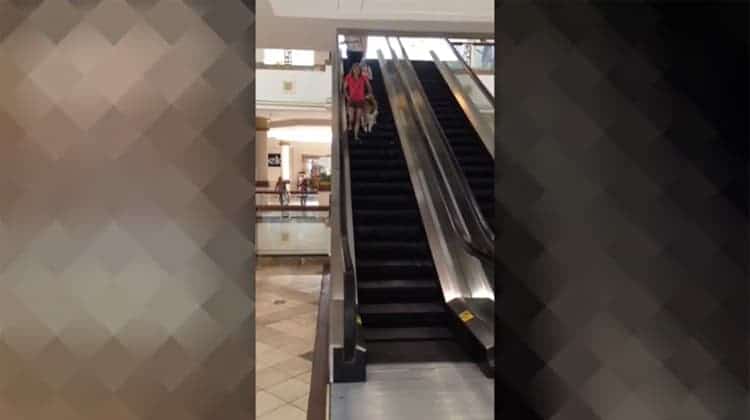
Video Description: Kolby taking Amelia on an escalator ride.
A Chance to Be a Dog
That is why Kolby is more amused than perturbed when people act sorry for Amelia and ask, “Doesn’t she ever get a chance to just be a dog?” If they witnessed Amelia’s joy during escalator rides, or the way she transforms at home once her harness comes off, or how she groans with satisfaction when receiving face rubs and butt scratches from her family – they would never ask that question.

Kolby also dotes on Amelia in other ways, like spending hours prepping her raw food diet to include a variety of fish, red meats, eggs, and fermented vegetables. She is a very cared-for Collie, as evidenced by the twice-daily teeth brushings and weekly groomings Kolby provides. Once a week, she also trims Amelia’s nails with a cordless, rechargeable Dremel grinding tool. On a monthly basis, their very understanding groomer allows Kolby to stay in the room with Amelia throughout the professional process that keeps her looking manicured and makes the at-home upkeep easier.
(Ironically, Kolby initially found Collie Chatter through a Google search that led her to my post about Rough Collie grooming, but I learned some things when Kolby described the method she uses to keep Amelia’s long, luxurious coat in top form. She starts with a slicker brush, goes through the coat again with a coarse comb, then finishes with a fine comb.)
A Pretty Good Trick
Clearly, the devotion between Kolby and Amelia is very much mutual. In their own ways, they spend a great deal of their lives caring for each other, and Kolby claims that the bond they share simply transcends words. When I asked if it could be possible that Amelia knows Kolby is blind, she responded, “I think she knows that I’m different and don’t see like other people do.”
To successfully act as Kolby’s eyes, Amelia was taught to follow directional cues (left, right, forward) and stop to signal changes in elevation like curbs and steps. She excels at “intelligent disobedience,” like halting on a forward command to indicate edges of subway platforms and random dropoffs in sidewalks or parking lots – giving Kolby a chance to extend her foot and feel out the terrain ahead.

Video Description: Amelia in harness, guiding Kolby down the street.
Sometimes people will ask Kolby, “Does she do any tricks?”
Kolby tries to be unfailingly polite, but she told me with some exasperation, “I think being a guide dog is a pretty good trick!” On a daily basis, Amelia does the specialized work that many consider to be the highest calling for a service dog. A trick dog merely has to repetitively perform the same behaviors, while a guide dog must regularly reason out how to adapt and apply learned behaviors to novel situations.
In Kolby’s words, “The bar is set very high to become guide dog. It’s the most difficult job you can ask of a dog, because of the independent thinking involved.”
It Must Serve a Purpose
Amelia does learn new things, such as when Kolby taught her the names of people to find (Mom, her friend Jen) or worked with her to add bathroom stalls and sinks to the list of items she can locate. Identification makes sense to Amelia. It’s useful. But when Kolby’s sister Kyleigh tries to teach Amelia to shake, Amelia gaslights her.
(Some of you familiar with canine behavior – particularly Collie behavior – may know what I’m talking about. Gaslighting is that moment when you tell your dog to do something, only to have them stare at you as if they’ve no idea what you’re talking about. If you’ve ever found yourself saying something like, “I’m not crazy to think you know how to do this, right? You did it three times yesterday!” chances are good you’ve been gaslighted by your dog, my friend. If an offer of treats suddenly, magically jogs their memory, consider it confirmed.)
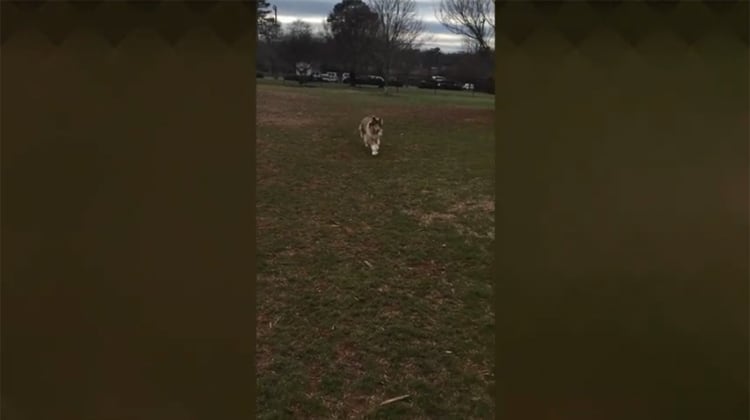
Video Description: Amelia running to Kolby off-leash.
Rather than present Kyleigh with the requested paw – seemingly a pointless exercise, in Amelia’s opinion – she offers an alternate behavior and throws herself to the floor with a ka-thunk. Lying down serves a purpose. It is something the humans generally act quite pleased about, and it is preferable to waving a paw in the air like a silly young puppy. (At least, this is what my female Collie Yoshi has communicated to me.)
Collies Are Big on Communication
Collies often display characteristics like not listening to just anyone who wants to order them around and ignoring commands they deem pointless or downright wrong. Amelia also inherited the vocalness common to many sheepdog breeds. Collies are big on communication, and Amelia is no exception. Kolby has had to work with her on not barking at inappropriate times or whining when another dog goes by.
The general public largely holds the misconception that guide dogs, unlike purely companion dogs, will be perfect. But as Kolby’s trainer so aptly put it, “You can put the assistant into the Assistance Dog, but you cannot ever take the dog out of the Assistance Dog.” At the end of the day, even the best-trained Assistance Dog is still just that – a dog.
Breed tendencies do play a role in a dog’s temperament, and what was once an asset in the breed’s original line of work may be a drawback in a different occupation. In Amelia’s case, where service dogs are preferably seen and not heard, her desire to communicate everything to Kolby is not always helpful. Technically, a service dog can be kicked out of establishments for being disruptive, and some people might consider even a whine disruptive.
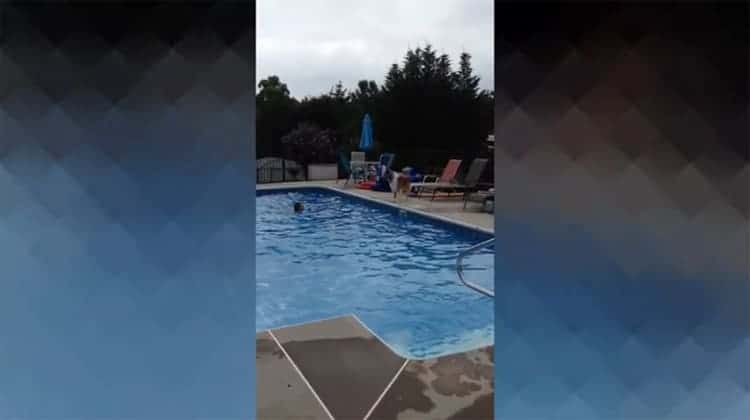
Video Description: A concerned Amelia barking at Kolby to leave the pool.
She Just Has a Lot to Say
Without being able to see what Amelia is barking at, correcting her can be difficult. (In my household, the two Collies are average barkers and the Aussie/Pyrenees mix is the real noisemaker. I’ve found one of the best ways to silence them is to acknowledge then dismiss whatever they bring to my attention, and visual cues are a big part of that.) Kolby pointed out that her family seem able to quiet Amelia with just a look, but for lack of eye contact Amelia may be trying to make her aware of what is happening around her through auditory means.
“I thought I could train her out of it, but I’ve come to realize that she just has a lot to say,” Kolby said. “I don’t always love the vocalness, but I trust her implicitly.”
It was gratifying to hear that Kolby read my article about Rough Collies and said, “Okay, I am not a bad handler!” I agreed and told her she just has a Collie! As behaviors go, Amelia is not a Collie anomaly.
Not Your Typical Guide Dog
However, being a Rough Collie, Amelia is not the typical guide dog material. She may even be one of the last Rough Collies or sheepherding breeds in general to be trained for such work by the GDF. The vocal tendencies have a lot to do with the the Guide Dog Foundation’s decision not to use Collies or German Shepherds anymore. Some considered them too difficult to handle, and they did not have a high enough success rate matching them with new handlers.
Some organizations like Freedom Guide Dogs in New York still use Smooth Collies. These shorthaired versions of the “Lassie breed” are often preferred over Roughs as service dogs since they have less coat, thus less upkeep. Amelia’s mother, Brooke, was a Smooth Collie donated to the GDF by a California woman, and her father was also a Smoothie. Both of them must have carried a longhaired gene, since Amelia was one of two rough-coated puppies out of their litter of six. Kolby met Amelia’s parents and some of her littermates, one of whom has gone on to be an ambassador dog for the GDF.

After being weaned, Amelia was raised, housetrained, and socialized by a wonderful woman named Andrea, one of many volunteer puppy raisers who take on the difficult, heart-wrenching task of fostering puppies for 16-18 months, then surrendering them to a higher calling. After 3-4 months of formal work with a sighted trainer, Amelia was 1 of only 2 dogs in her class who graduated, joining the elite group of dogs deemed fit for the intensive work of guiding a person who is blind or visually impaired. Kolby is still in contact with Andrea, and even does Facetime video calls with her so she can see Amelia.
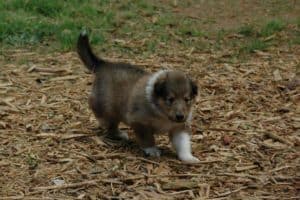
What Happens Next
When the time comes for Amelia to be retired, Kolby has the option to offer Amelia back to Andrea or to Glenna, who supervised Amelia’s first weeks of life and still has Brooke, Amelia’s mom. But if she is financially able to at the time, Kolby hopes to let Amelia live out her more relaxed, golden years with her as a treasured companion. If neither Kolby nor Andrea were able to keep Amelia, she could go to live with another friend or family member she knows well, like Kolby’s sister Kyleigh.
In the unlikely event no one in their inner circle could meet Kolby’s condition of continuing to feed Amelia a raw diet, there would still be no shortage of people willing to to treat her like a queen emeritus. On a yearly basis, the names of many people eager to adopt a retired service dog are added onto waiting lists.

But all of those concerns are years in the future for Kolby and Amelia. They have been a team for over 5 years now, and they still have a lot to accomplish together. Currently, Kolby is working to increase her speed and accuracy with a steno machine and become a court stenographer. She still has to pass skills exams in 3 different categories of dictation that require typing speeds of 180-225 words per minute with 95% accuracy. Kolby says maintaining the focus necessary to not miss any words and getting her fingers to move that fast are among the hardest things she has ever done.
Once those hurdles are passed, Kolby will be an official court reporter. It’s fortunate that Amelia has a good on/off switch that allows her to lie down and take a nap next to Kolby while she is otherwise occupied. Beyond that, Amelia has the understanding to know that while in harness, she is on duty. Soon, Kolby and Amelia will be going to work together.

How to Show Respect
Kolby made it clear that the best way to show respect for a handler and service dog team is to pretend they are not there. Here are some general guidelines to follow when you spot a person with their assistance dog:
- Ignore them, so they can do their job.
- You can look at them, but please don't make a big deal out of their presence.
- Don't make distracting kissie noises or otherwise try to get the dog to look at or acknowledge you.
- Don't ask to pet the service dog: they are there for their person, not your entertainment or enjoyment.
- Realize that they do get to relax and be dogs at home.
As it is, Kolby and Amelia spend a lot of time educating the public and being unofficial breed ambassadors. They do hear “Lassie!” countless times, but Kolby also gets asked if her dog is a Border Collie or a Sheltie (or “mini Collie,” as some people erroneously call Shetland Sheepdogs.) In reality, weighing 50-plus pounds and standing 24 inches at the shoulder, Amelia is taller than a Border Collie (height: 18-22 inches) and twice the size of a Shetland Sheepdog (weight: 15-25 pounds). Still, when people hear, “This is a Rough Collie,” it can be somewhat of a revelation if they are unfamiliar with “Lassie dogs.”
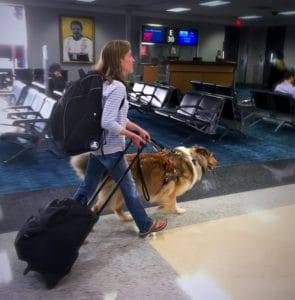
Sassy Lassie
Amelia may not be a movie star, but Kolby calls her a “sassy Lassie” and “a bit of a diva.” She says Amelia’s top four descriptors are “effervescent, enthusiastic, quirky, and vocal.” Though not as cuddly as Sunny was and technically not allowed on furniture without permission, she does like to get in bed with Kyleigh, who is less strict about such things.
When I asked Kolby for any final words before concluding our interview, she said:
“My guide dog enhances my independence and enriches and impacts my life in ways that I cannot put into words. Thank you to Amelia’s puppy raiser, Andrea, and to the Guide Dog Foundation, for giving me the dog who has become my eyes.”
Follow this link for further reading about guide dogs in general.
If you enjoyed this post, get free updates by email.
If you have any questions or input about this post, feel free to leave it in the comments below!
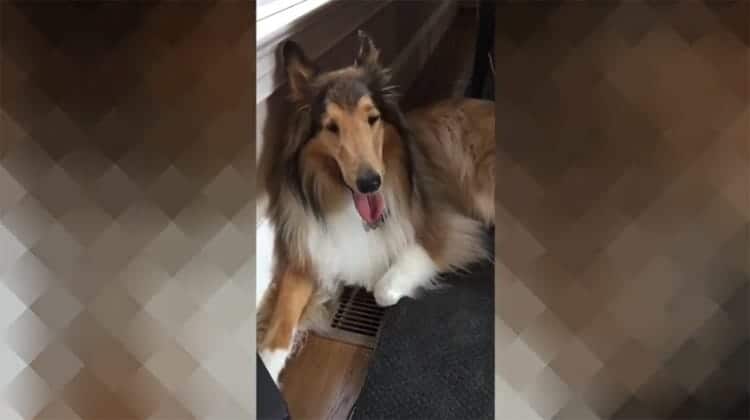
Video Description: Amelia resting on an AC vent after playing hard.
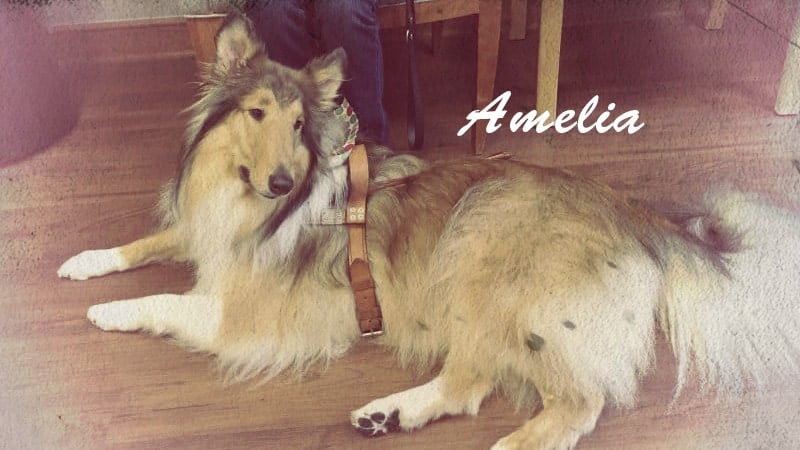

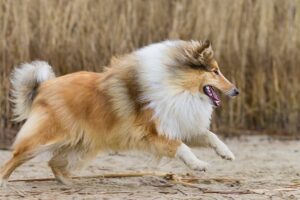


Yay, another rough collie service dog. Beautiful descriptions and story.
I told Kolby about you and Runa! ? Talking to you helped me know what questions to ask her. I do wonder how many Collie service dogs are out there.
Great job Kolby!
I’m trying to find a rough collie service dog organization. I have balance issues and I’m poly blind on my right side vision. All the service animals I see are manly golden retrievers, labs, and a mix of those breeds. I love all dogs but I like collies better than golden retrievers. I found one place but it’s in Oregon. I live all the way near the 13 states. Let me know about other service that offers collies.
Hi Cameron!
Veronica Sanchez is a professional trainer who has been in that career since the 1990s. She does have experience training dual mobility-guide dogs, and she lives in northern Virginia. Not only did she train her own Rough Collie and now Smooth Collies as service dogs to help with her dystonia, but also she has worked with owner-trainers and non-profit service dog programs. If you contact Veronica at Cooperative Paws Service Dogs Education, you can send her a message through the contact form. Under the “I am inquiring about” heading, there is an option to select “Help training or acquiring a service dog.” Good luck, and please do let me know if she is able to help you!
Best regards,
Emily Sowulewski
Thanks! I do not live in another state to Virginia. I’m just researching about service dogs right now since we are all in lockdown from the virus. I have learned a lot. If I can convince my parents to let me get a puppy. I will contact her. I will save her website. This is great info you shared me.
I was thinking us there a collie training service to train your collie to be a service dog, like the one in Virginia in NC?
The majority of people who use Collies as service dogs owner-train and consult with a breeder and trainer to select and train the best possible Collie to assist them with their specific needs. (As in this story I wrote about Kyndyl and their Rough Collie service dog, Runa.)
It took some digging to even find Veronica Sanchez with Cooperative Paws Service Dog Education. Other than her and King’s Valley Collies in Oregon, I am not aware of any service dog trainers who exclusively or personally train Collies for service work. I may be a Collie owner who enjoys writing stories for her hobby blog, but by no means do I consider myself an expert or a professional trainer.
However, I’m happy to refer people to experts! My best advice is still to reach out to Veronica and ask if she can connect you with someone in North Carolina who can help you. Since she is already involved with Collies, service dogs, and professional dog trainers, she would be an excellent person to network with. If you click this link, it will take you directly to the contact form on her website.
I think it would also be a good idea for you to contact King’s Valley Collies. Tell them that Emily from Collie Chatter sent you. I’m not arrogant enough to think they’ll know or remember lowly little me, but you could mention that Pati Merill is my mentor. That name may open doors for you! Pati is the former president of both the Collie Club of America and the Collie Health Foundation. It seems that everyone in the Collie world knows who Pati is. 🙂
Best of luck to you! Please do come back and let me know if you have any success finding someone in North Carolina who can help you out. I’m always looking to add people to my list of resources so I will better know how to direct people in the future.
Thanks for the suggestion. Like I said I’m more a yorkie lover. But I love all dogs. When I was a kid I read Lassie come home, saw the tv show on reruns. I always thought they where very beautiful dogs. I was researching. On service dog. I kept coming to this blog, and I saw an old video from Kings valley Collies. The video is a lot of things I need help at like mobility, balance, etc. I contacted them on Facebook. But they are to far to travel. I kept finding Golden retrievers and labs. I hear German Shepard’s, and poodles are great dogs to and collies. So I’ve been researching how to train your own dog. I will contact that lady in Virginia. It’s pretty close. Thanks for this blog posts and all the great info.
You’re smart to research and ask lots of questions before deciding on what dog breed would be best for you. I obviously love Collies, but I won’t say that they’re right for everyone. For some people though, they’re just right. 🙂 Good luck with everything, Cameron!